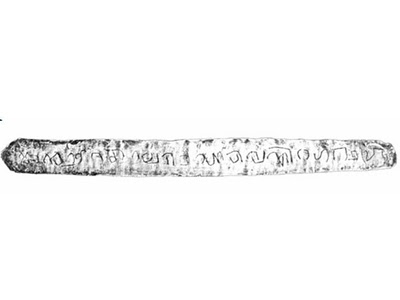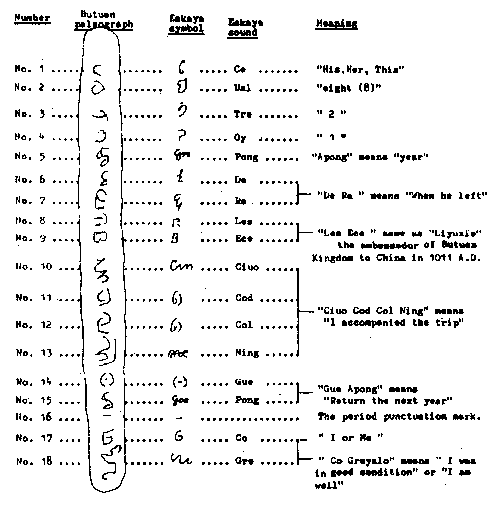
The Butuan Silver Strip
by Hector Santos
© 1996 by Hector Santos
All rights reserved.
http://www.bibingka.com/dahon/mystery/silver.htm
The Butuan area has been a rich source of material from ancient Philippines for both treasure hunters and trained archaeologists. So it was in the mid-seventies when a team from the National Museum of the Philippines excavating a site was told that a strip of metal with some kind of writing had been found by a treasure hunter.
Fortunately, the artifact was already in the hands of Proceso Gonzales, the city engineer of Butuan. He understood the importance of the find and took possession of it.
Butuan Silver Strip
The metal strip was found inside a wooden coffin by treasure hunters who were looking for ceramic and gold objects that could be sold for high prices to private collectors. According to Dr. Jesus Peralta, similar burials in wooden coffins in the vicinity of Butuan had previously been found to contain human remains with skulls that have been artificially deformed. This practice was apparently limited to Southern Philippines, the beauty standard for such head shapes never finding its way to Luzon.
Ceramics and ornaments were usually placed in the coffins, the ceramic pieces dating from the 14th and 15th centuries. If the metal strip was found within a typical coffin, it would have logically come from the same era.
While the metal piece could have come from foreign shores, the safest and most conservative position one can take is that an artifact belongs in the place where it was found unless it can be proven otherwise.
The letters were cut into the piece of metal with a knife. The difficulty of making curved lines on metal with a knife is apparent in the clumsy shapes of the letters. The strip measures 17.8 x 1.3 cm.
Peralta reports that the late Dr. Boechari of Indonesia identified the script as “similar to a Javanese script that had been in use from the 12th to the 15th century” (late Kavi?).
At this time, the writing has not been convincingly deciphered nor have the letters in the strip been identified. A successful transliteration would not guarantee a decipherment because of the brevity of the sample, though.
A companion piece with similar writing was also reportedly found in the same coffin. However, the owner refused to part with it because he believed it held the key to the location of a treasure hoard. How he hoped to use that piece to locate the treasure without translating the message is not known. Neither do we know why it is that piece and not the one he gave up that holds the secret.
That second piece will play an important role in solving the mystery of the Butuan silver strip.
Additional Reading
1. Peralta, Jesus T. “The Butuan palaeograph: ethnographic implications of an ancient script,” in Archipelago 6:A-55 (1979): 31-33.
2. Santos, Hector. “Artifacts with writing revisited” in Sulat sa Tansô, 2:5 (June 1995), 1.
3. —–. “Other pre-Hispanic writing artifacts” in Sulat sa Tansô, 2:2 (February 1995), 1.
4. —–. “The Butuan Silver Strip” in Sulat sa Tansô, 2:2 (February 1995), 3.
Butuan Silver Strip Deciphered?
by Hector Santos
© 1996 by Hector Santos
All rights reserved.
“Butuan paleograph deciphered using Eskaya script” by Jes Tirol (in UB Update) attempts to show that a “translation” of the Butuan silver strip had been done by using the Eskaya script. A clipping of this article was provided by Antoon Postma of Mindoro, who in turn obtained it from the late William Henry Scott of Mountain Province. This proves that “real” scholars do share information.
Eskaya is a secret organization based on the island of Bohol. Its members claim that their ancestors arrived on the island in 677 A.D. from Sumatra. Tirol writes:
One of the books of the Eskaya of Bohol is entitled Unang Katawhan Sa Bohol (First People of Bohol). According to the book, Dangko and his 12 children of 11 boys and one girl and his men arrived in Bohol in 677 A.D. They started from Sumatra-Manselis which is the western side of Sumatra, Indonesia on board a “Lutsa.” (See: “Lorcha,” Webster Int’l Dictionary, Unabridged.)
The only daughter of Dangko got married to a chieftain of Butuan. From that time on until the present, the inner psyche of an Eskaya is geared towards Butuan. Since the center of Eskaya culture is now at Biyabas, Guindulman, Bohol, the migrant Eskaya in Butuan maintain close contact with the Eskaya of Bohol.
Further on, Tirol continues:
The Butuan Kingdom is no more. Its literature and writings are gone, except for the Butuan paleograph. But the Eskaya of Bohol is still existing with their system of writing. It is logographic system not alphabetic, and therefore older than the Malayan-Bisayan recorded by the Spanish writers. The Eskaya scrupulously transmitted their system of writing and literature by conducting classes. At present, classes are conducted every Saturday and Sunday.
The Eskaya were once part of the Butuan thalossocracy. There is therefore no reason to doubt that the system of writing of the present Eskaya is the same as that of Butuan of olden times. But due to passage of time and cultural intrusions there will be variations, but basically it should be the same.
A chart showing values for the symbols of the Eskaya script provided by Jesus T. Peralta of the National Museum is shown on the Eskaya page. There are many interesting things in the chart. One is that Eskaya writing system includes symbols for numerals, even one for “zero.” It also includes symbols for consonant clusters, a characteristic that was not a feature of old Philippine languages. However, the most interesting thing for me was that some of the symbols can be seen on the Calatagan jar.
A cursory look at the script chart shows that similarities between symbols whose values are closely related are not there. I get the impression that this was an artificially created script, perhaps devised by one individual. It does not seem to be a writing system that had evolved over several generations.
Be that as it may, let us now examine the translation provided by Tirol. The figure below relates the symbols on the silver strip to those of Eskaya and their corresponding phonetic values and meanings.
Translation Chart
The translation reads as follows:
This 821 year when Liyuxie (Les Ece) traveled, I accompanied the trip and returned the next year. I was in good condition.
I will repeat the Eskaya sound and Meaning columns from the above chart below for those who find them hard to read.
1 Ce “His , Her, This”
2 Ual “eight (8)”
3 Tre “2″
4 Oy “1″
5 Pong “Apong” means “year”
6 De “De Ra” means
7 Ra “When he left”
8 Les “Les Ece” same as
9 Ece “Liyuxie” the ambassador of Butuan Kingdom to China in 1011 A.D.
10 Ciuo “Ciou Cod Col Ning”
11 Cod means
12 Col “I accompanied the trip”
13 Ning
14 Gue “Gue Apong” means
15 Pong “Return the next year”
16 The period punctuation mark
17 Co “I or me”
18 Gre “Co Greyalo” means “I was in good condition or I am well
Quoting W.H. Scott (Filipinos in China Before 1500; Manila, 1989, p. 4.), Tirol explains:
In the year 1003 A.D., King Kiling of Butuan sent his ambassadors, Liyihan and Jiaminan to the Sung Court of China. In 1011 A.D., another king of Butuan, Sri Bata Shaja (Xi-li-ba-da-sha-zhi) sent Liyu-xie to china with a memorial engraved on a gold tablet. Liyu-xie obtained a recognition from China that Butuan had equal status with Vietnam (Champa) as China’s tributary.
Regarding the date, Tirol does not explain 821 but says:
The experts of the National Museum estimated the date of the paleograph between the 12th to 15th century. The date of the trip of Liyuxie which is being referred to, occurred in the 11th century. This difference of one century is acceptable in archeology. The paleograph was found in Butuan and the inscriptions refer to an important person of Butuan.
The silver strip was found with material dated 14/15th century not as early as the 12th century as Tirol wrote. While it is true that 821 in the Islamic calendar would be the equivalent of our 15th century, the characters of the proposed translation would have lived four centuries before the artifact came into existence. That certainly is too much water under the bridge to establish a connection.
More studies on the Eskaya can verify whether there is truth to their claimed connection to an ancient group of people from Sumatra or whether they came up in recent times and developed an artificial script for secret messages.
Additional Reading
1. Peralta, Jesus T. “The Butuan palaeograph: ethnographic implications of an ancient script,” in Archipelago 6:A-55 (1979): 31-33.
2. Santos, Hector. “Artifacts with writing revisited” in Sulat sa Tansô, 2:5 (June 1995), 1.
3. —–. “Butuan silver strip deciphered?” in Sulat sa Tansô, 2:5 (June 1995), 6-7.
4. —–. “Other pre-Hispanic writing artifacts” in Sulat sa Tansô, 2:2 (February 1995), 1.
5. —–. “The Butuan Silver Strip” in Sulat sa Tansô, 2:2 (February 1995), 3.
6. Tirol, Jes B. “Butuan paleograph deciphered using Eskaya script,” in UB Update 1:4 (1990): 6 ff. (Note: A University of Bohol publication.)
7. —–. “ESKAYA OF BOHOL: Origin of Its System of Writing” in The Bohol Chronicle XL: 10 (July 11, 1993), 3 ff.

Original Article at: http://www.bibingka.com/dahon/mystery/silver.htm
















